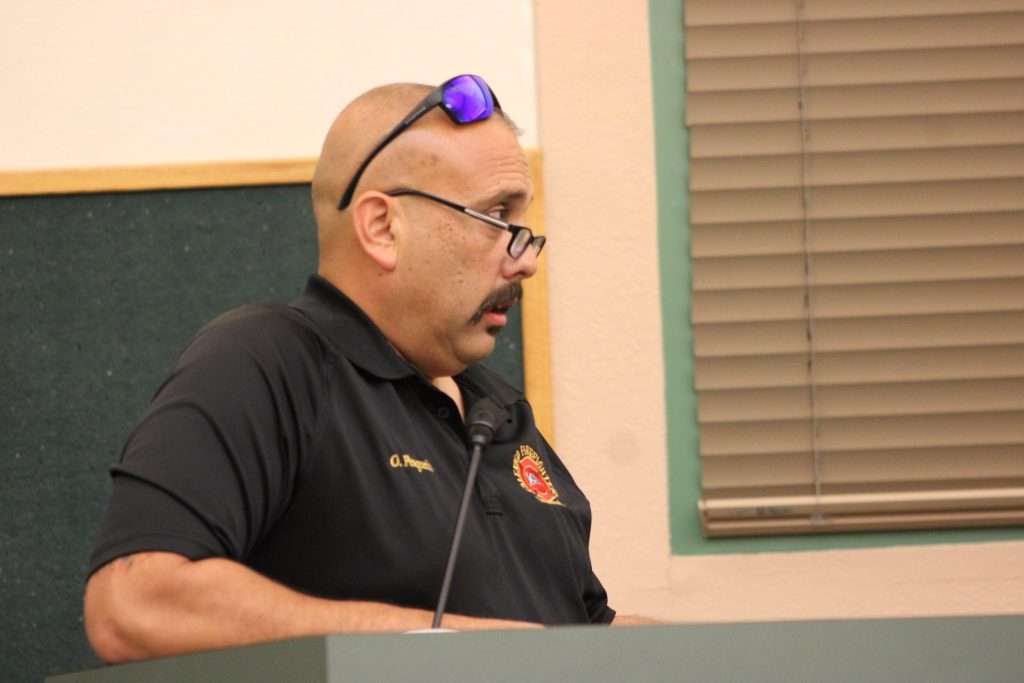CALEXICO — Having experienced abnormal heart rhythms himself, Calexico fire Engineer Oscar Pesqueda advocated for his union to get the funding to equip his firehouse with an emergency alarm system with “heartsaver tones.”
“I was one of the ones that was treated for tachycardia. But I’ve been doing it for 25 years or more. So it takes a toll,” Pesqueda said on Wednesday night, May 15, revealing his own health concerns from the line of duty.
“Technology has improved so much and we just want to focus on the best treatment and response,” he explained to the City Council.
At issue was an emergency agenda item from the Calexico Firefighter Association requesting a reallocation of American Rescue Plan Act funds in the amount of $26,472.41 to use at Fire Station No. 1 for the purchase of an alert system with “heartsaver tones” meant to gradually alert first responders inside the station, and hopefully reduce the strain on firefighters’ health. The purchase would be part of the association’s Health and Wellness Project to improve longevity in Fire Department employees.


The allocation was unanimously approved by the council and will cover half of the cost for a new alert and sound system used to notify the first responders of an emergency call.
“Community Benefit Grant Program from the (Imperial County) Board of Supervisors in October 2023 granted the department $25,000 in funding to aid in updating old and expired equipment. If the city agrees to share the cost of the needed system, the Calexico Firefighters Association will donate the equipment that we will buy with the grant funding,” interim Calexico Fire Chief Matthew Bush explained to the council.
Bush thanked City Manager Esperanza Colio Warren for her hard work to assist the Fire Department in finding additional funding through other avenues, since the city has not been able to fund these improvements.
“We’re hoping to get additional funding, and we’re working with the state to get additional funding for the dispatcher center and the Fire Station No. 2. We don’t have that mechanism or the funding available to do it, to do the overall project for two stations with this budget,” Colio said, explaining why the grant search was necessary.
The new system will produce a light first, and then emit a tone which will sound off only in certain regions of the fire station, rather than the entire building. The current system in place, not just in Calexico but in many departments across the nation, sounds throughout the entire building at a single volume.
What the new system offers, “they call it ‘ramp up tones’ or ‘heartsaver tones.’ It ramps up in audio to kind of be a little softer to wake you up,” Calexico Firefighter Joshua Paddock.
Part of the new technology is a lighting system, which gives a pre-alert before the sound begins, and then builds up in pitch. “Multiple guys have been treated for tachycardia at our department, high heart rates, and this type of tone out that we currently have, has been shown through studies that it will be able to take your heart rate up to (the) 160s right when you hear the tone, it’s so loud,” Paddock said.
The remote system in place currently blares through the entire firehouse throughout the day and night, with the station responding to about 5,000 calls in a year, with an average of 14 calls a day, Paddock said.
The calls wake up and alert nine or 10 firefighters to each call, where only two people typically respond at a time to 80 percent of the calls, depending upon what type of safety call is received. As the busiest fire station in the county, and especially while working out of only one location while Fire Station No. 2 is under construction and uninhabitable, the Calexico crew is worn out.
“That takes a toll on you after a while. Other technologies put out like these, that do remotely only dispatch the unit that’s going, to let the other guys sleep, and get that rest, get that recuperation,” Paddock told the council, explaining the situation.
The current notification method is similar to an old public address system with megahertz radio, and Paddock said, “It’s like a shock to the heart and guys at the station say it’s a punch in the chest in the middle of the night. It’s very loud, with one tone at 100 miles an hour.”
Paddock explained that the continuous calls at their current tone affect the crew psychologically and physically. “And we’re just trying to mitigate unnecessary stress as much as possible,” he stated.
“Just to relate, I know last month we had a fairly large quake like 12:30 at night,” Engineer Pesqueda said.
“And how did you wake up from that? How did you feel? Feels pretty bad, right? And we go through it two, three times a night. And 10, 12, 15 times a month,” Pesqueda told the City Council. “So if we do the math, this is going to save us, keep focused, keep us healthy.”
Camera’s Funded By Border Patrol
U.S. Customs and Border Protection updated a more than 20-year long agreement with the city of Calexico at the May 15 council meeting, approving the construction, operation and maintenance of a communications and Remote Video Surveillance System to be placed at Nosotros Park on Kloke Road in Calexico.
The original agreement began July 1, 2000, and expired on June 30, 2020, which then continued on a month-to-month basis until better agreements could be made between the entities. The City Council and staff met with the federal government to draft a new agreement that will bring a much higher level of funding to the city.
With an annual collection of $750 per month and a 2 percent increase annually, this will bring the city a total of $9,000 in just the first year of the agreement, compared to the $1 a year fee the USBP was previously charged for 20 years.
The new agreement will bring total revenue of more than $214,000 to the city over the next 20 years, with the agreement to end in September 2043.
Imperial Valley Equity & Justice Coalition had a presence at the meeting to express its concerns with the updated camera system and agreement. Daniela Flores, executive organizer for the coalition, read a letter that expressed concern for human safety and rights by cameras using new Artificial Intelligence technology to monitor activity.
“These towers will be controlled by algorithms that will automatically detect, identify, track and classify objects of interest,” Flores said. “This means that everything that falls under the gaze of the cameras will be scanned and categorized to an extent that AI will automatically decide what to monitor and recommend when Border Patrol officers should be dispatched.
“AI is prone to mistakes and difficult to hold accountable. In an era where the public has grave concerns about the impact of unchecked technology on youth and communities of color, we do not believe enough scrutiny and skepticism has been applied to this agreement and CBPS proposal,” Flores read from the letter.
“For example, the item contains very little in terms of describing what kinds of data will be collected, how long it will be stored and what measures will be taken to mitigate the potential threats to privacy and human rights,” the I.V. Equity leader said, emphasizing points that the coalition works hard to speak up about.
While people’s rights were a concern for the coalition, other residents expressed that they felt the cameras would contribute to an added feeling of security in the region, to monitor other criminal activities, which these cameras have helped solve in the past.
The motion passed 2-1 after hearing from the public, with former Gloria Romo standing as the only vote against the action.


Budget Talks
The council heard the 2023-2024 Third Quarter Budget Status Report, which was presented by interim Finance Director Sandra Fonseca, who said the city was on track with its nine-month expenditures budget, and overall the city was in a decent position.
“The Fire Department is over its budget in salary and benefits but currently have savings and expenses due to contracts not expiring until June 2024. While vacancies contribute to the budget surplus, staffing shortages present continuing challenges to all departments to deliver customer service both internally and externally to the public,” Fonseca said.
“So we keep complaining that we have no money? Considering other years, we have more money. And we’re not spending,” resident Joong Kim asked the council, frustrated with the financial state of the city.
“Please, we have a lot of money there. We are supposed to spend money (on) the citizens and our future,” Kim told the council, speaking from his former council member experience.
“We’ve never had a reserve until last year,” City Manager Colio said, responding to some of the confusion.
She mentioned that the city’s decision to build a financial reserve was made based on the recommendation of state auditors. “But it doesn’t mean that we have a lot of funding available. We’re just trying to mitigate what we don’t have reserves for,” Colio said, answering concerns from council members that questioned what can be done with the funding still in the bank.
The city manager reminded the council that there is still a portion of the fiscal year to get through and those funds will more than likely be used in that timeframe.
“As you’ve been hearing and hearing from the public, it has been very hard for the employees of the city to be able to maintain. But I know that they’ve done other efforts and I want to thank them, and department heads because even though they have all these shortfalls, they continue to work as a team trying to make the city nice,” the city employee said, crediting her coworkers.
The general year-to-date sales tax revenues have increased 6 percent from the prior year, Fonseca explained, providing further detail in a slideshow for the public.
The recommended proposed budget for the upcoming fiscal year had three financial policy objectives, Fonseca said, listing them. “The first one — build reserves. Second — pay down debt, and the third — invest in city programs,” she concluded.








